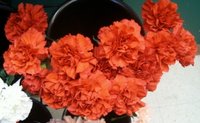A Perfect Balance of Micro and Macronutrients

A few postings ago, I told you how I switched over my main nutrient source to Sensi One Grow and Sensi One Bloom, with the addition of Overdrive to guarantee fast and prolific bud formations as well as large flower size.
Since then, I’ve been finding out wonderful things about my main nutrients. Sensi One Grow NPK: 13-4-12 and Sensi One Bloom NPK: 11-8-17 are the best powdered concentrates specifically designed for the vegetative growth and the flowering cycles of my carnations.
The micro and macro nutrients in both of these products are perfectly balanced. They contain Ammonium Nitrate, Boron EDTA, Boron Proteinate, Calcium Carbonate, Calcium Chelate, Calcium Nitrate, Di-Potassium Phosphate, Iron DPTA, Iron EDDHA, Iron EDTA, Iron Proteinate, Magnesium Carbonate, Magnesium Nitrate, Magnesium Phosphate, and Magnesium Sulphate/Sulfate.
Furthermore, the ingredients in these two products include Manganese EDTA, Manganese Proteinate, Molybdenum EDTA, Mono Potassium Phosphate, Phosphoric Acid, Potassium Bicarbonate, Potassium Borate, Potassium Carbonate, Potassium Nitrate, Potassium Phosphate, Potassium Sulphate/Sulfate, Urea, Zinc EDTA, and Zinc Proteinate.
No I don’t have a scientific mind and they might as well be talking gibberish when the Advanced Nutrients website lists these names of synthetic nutrients. However, I do know how to punch things up on Google and there I found that Boron, just to pick one at random, is an essential micronutrient for plants, even though its role in plant metabolism is not fully understood.
Normal cell division is thwarted by a case of boron deficiency. This can result in the development of side shoots, which I definitely do not want on my carnations, as well as brown specks and stripes on the stems and the leaves, which would lessen the market value of my flowers.
In addition to Overdrive, I will start using Bud Blood in week one of flowering, Big Bud in weeks two, three, and four, and Overdrive in weeks five and six. Then I’ll give the bloom accelerators a rest.
I always keep in mind that I can’t use the above three products at the very same time. This would burn my carnations to a crisp.
The size of my flowers is increasing and more markets are opening up for my carnations. I enjoy making beautiful bouquets just as much as tending my sensitive crop of long-stem Sim carnations.
posted by Jill @ 2:49 AM
0 comments
![]()



